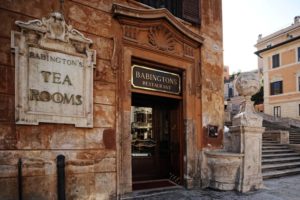 Since the 1700s for Northern Europeans on the “Grand Tour” all roads have led to Rome. They entered the Eternal City through the Porta del Popolo, a gate in the ancient Aurelian Walls built by Pope Sixtus IV for the Jubilee Year 1475, and took lodgings in and around Piazza di Spagna, still a favorite destination with foreign tourists.
Since the 1700s for Northern Europeans on the “Grand Tour” all roads have led to Rome. They entered the Eternal City through the Porta del Popolo, a gate in the ancient Aurelian Walls built by Pope Sixtus IV for the Jubilee Year 1475, and took lodgings in and around Piazza di Spagna, still a favorite destination with foreign tourists.
In fact, in less than a century, guidebooks had started describing the Piazza and its off-shooting streets “an English colony” with English shops, English boarding houses, an English pharmacy and even an Anglican church “All Saints” built in 1822 and still in existence on Via del Babuino. In short, all the comforts of home except an English tearoom! That is until December 5, 1893, when Miss Anna Maria Babington and Miss Isabel Cargill opened theirs at 66 Via Due Macelli. They’d met a few years before in London. Miss Babington had moved there from Derbyshire to create an independent life for herself and Miss Cargill, a transplanted Scot, from New Zealand to visit family and mend a broken heart. Knowing that her 100 pounds sterling wouldn’t go far in London, Miss Babington asked Miss Cargill to join her in a business venture in Rome. As Joe Wolff’s charming book Café Life in Rome recounts: “The timing was perfect. In addition to the thriving English community in Rome, 50,000 pilgrims arrived to celebrate the Jubilee of Pope Leo XIII, along with the ‘A’ list of Europe who came to celebrate the silver wedding anniversary of the king and queen of Italy.”
Babington’s Tearooms was an immediate success. “Finally a place in Rome served a ‘proper cup of tea’”, [until then tea was only purchasable in pharmacies], continues Wolff, “-not to mention offering special toilet facilities for women at a time when there wasn’t much available, and this was an ‘unmentionable’ problem.” Within only three years they’d transferred their business to its present location at Piazza di Spagna 23 and opened a second branch on Via Rusticucci near Piazza San Pietro. This was closed when Mussolini built his wide avenue Via della Conciliazione from the Tiber to St. Peter’s Square in 1940.
Until the First World War business flourished and Miss Cargill married the painter Giuseppe da Pozzo, whose portrait of Miss Babington still hangs in the Tearooms. They had a daughter Dorothy, who, after Miss Babington’s sudden death in 1929, helped her mother along with her Aunt Annie, who’d come to their rescue from New Zealand bringing her life’s savings.
Ironically during the xenophobic decade of Fascism Babington’s unexplainably flourished with the black shirts hobnobbing in one room and the anti-regime intelligentsia (with their emergency exit through the kitchen) confabulating in the other. And not only that, during World War II, when Dorothy, her aging mother and her four children evacuated to Cortina, the Tearooms survived thanks to the ingenuity of three staff members, Crescenza, Giulia and Anita. They used their own rations to invent nut croquettes, potato-flour bread, chick-pea flour scones and dried-chestnut flour cakes. During the whole course of the war, the Tearooms were closed only for a few hours when the Allies’ entered Rome.
Post-War tourists wanted more than a quiet “cuppa” and English-language newspapers, so the next generation, Dorothy’s children (three boys and one girl Diana, who all had English spouses), expanded the menu to include a full English breakfast, Rome’s first hamburgers and club sandwiches, aperitifs, wines, cocktails and their then newly-concocted signature tea.
From 1960 to 1975, during “La Dolce Vita”’s heyday, Elsa Morante wrote her novels longhand, while chain-smoking, in a corner reserved for her; actor Vittorio Gassmann was a regular too; film director Federico Fellini, who lived on nearby Via Margutta, was a fan of Babington’s “Ham and Cheese English Muffin”, and Elizabeth Taylor and Richard Burton, still married to other spouses, met secretly here during the filming of “Cleopatra”.
Today Rory Bruce and his cousin Chiara Bedini, two of Dorothy’s grandchildren, run the Tearooms, open everyday from 10 AM to 9:15 PM. Besides Babington’s own blend, they serve 24 tea varieties. The accompanying teatime Scottish scones with butter and homemade strawberry jam are their great-grandmother’s recipe. Otherwise, at mealtimes try their “Blushing Bunny” (grilled tomato, creamy Italian cheese, and mushroom on toast), “Canarino”(poached egg on rice pilaf with a tangy cheese sauce), curry or a Scandian Roll with chicken and mushrooms.
Besides refreshments, omnipresent Rory and Chiara host concerts, tea tastings, and their annual Christmas Carols sing-alongs. They’ve also added children’s lunch and tea menus and a store selling unique Babington’s blends, other teas from all over the world, tableware, gift cards for friends and family on a 21st-century “Grand Tour”, and Il Messaggero health columnist Carla Massi’s hot-off-the-press anecdotal volume “Il Tè dei 125 anni”, well-illustrated with family photographs (45 euros) and for now only available in Italian. On January 23 it was presented at Villa Wolkonsky, the residence of the British ambassador to Italy.
